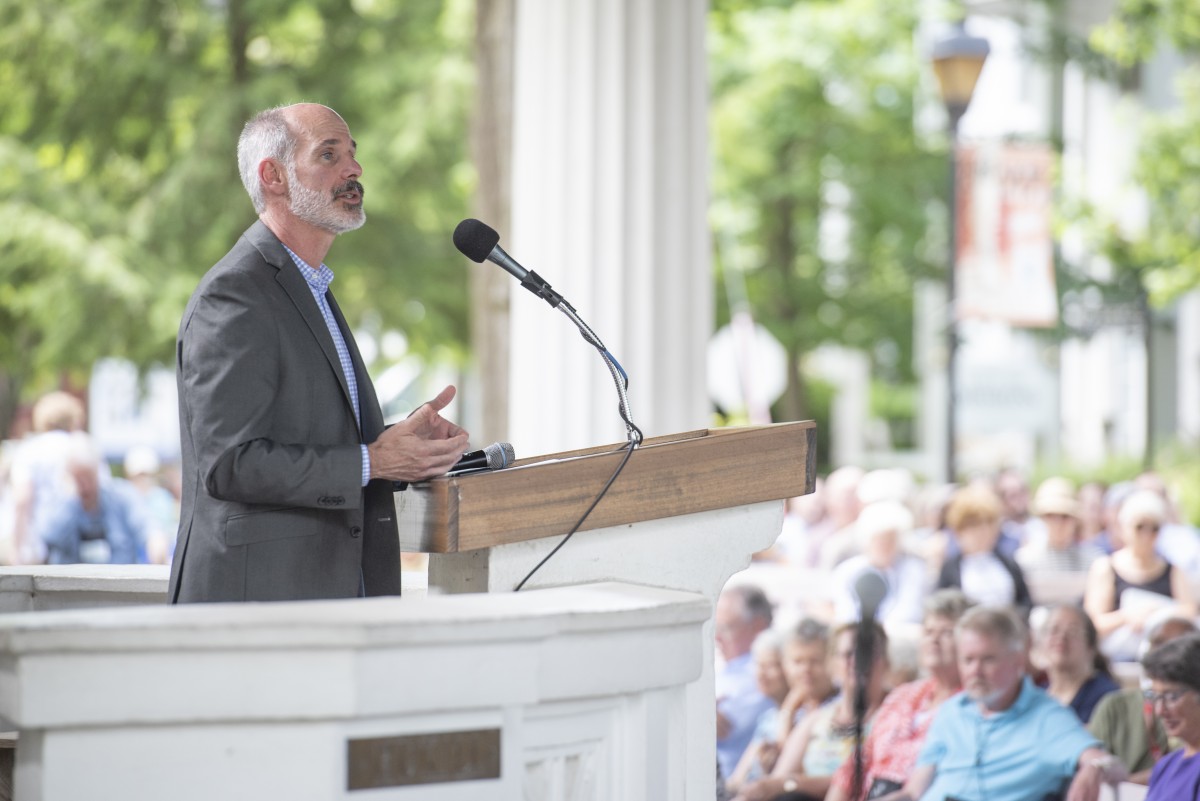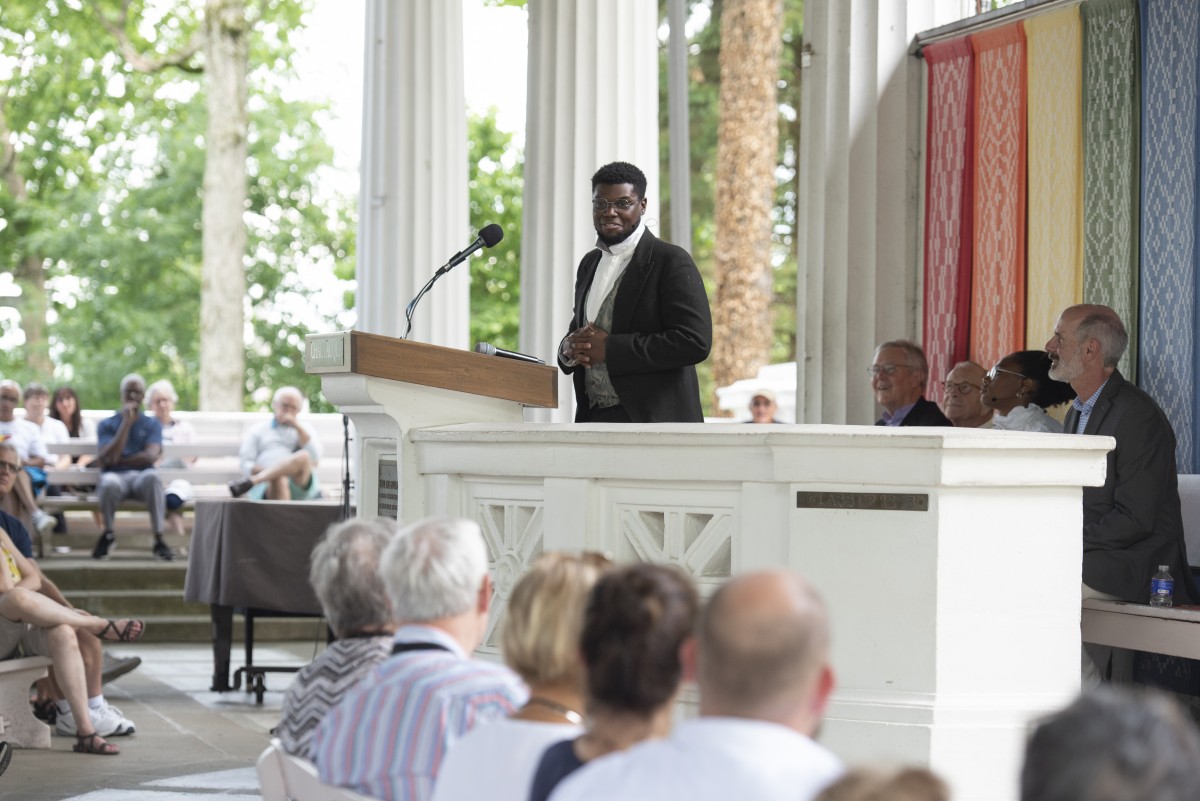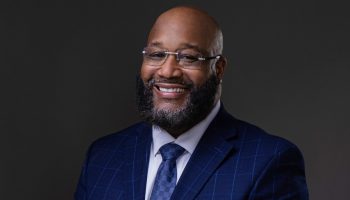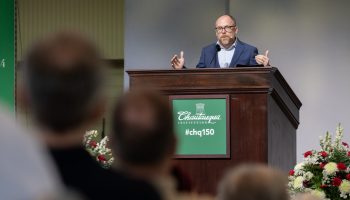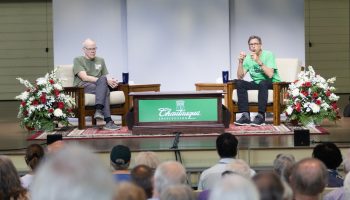The word “history” holds more meaning than just being a record of events.
“I don’t want to just talk about our history; I want us to talk about our story, and it is our story,” said Chuck Yarborough, who in April was named the Organization of American Historians Tachau Teacher of the Year. “Black history, white history, Jewish history, Christian, rich, poor male, female — all of it is our story.”
As a continuation of the Week Two interfaith theme, “Common Good Change Agents,” Yarborough, a history teacher at the Mississippi School for Mathematics and Science, and two of his students addressed the role of history in their lecture, titled “Burial Ground is Common Ground,” in conversation with The Atlantic’s James Fallows.
Yarborough incorporated two projects into his curriculum for students to help them connect with the history and community of Columbus, Mississippi.
“The reason the projects that we’ll talk about today resonate is because so many of us understand that we’ve not been allowed to understand and engage that complete, complex story,” Yarborough said. “We’ve been tackling tough issues together by exploring our communities, our states and our nation’s story on the common ground of the burial ground, our cemeteries.”
Yarborough literally means exploring cemeteries. Every year, he presents a list of people to his students: people who died before 1930, lived in Columbus, Mississippi, and contributed to the history of the town. Some of the names on the list are from Yarborough wandering around the local cemetery. His students then pick an individual to research in Columbus’ local library archives and the Mississippi Department of Archives and History in Jackson, Mississippi. This research is a part of the first project titled “Tales from the Crypt,” that students work on in Yarborough’s class.
“I challenge them to think about looking through the life of somebody and thinking of that as a window,” Yarborough said.
After conducting primary research from August to November, the students write research papers and create a performance, based on the person they researched, to present to the community — staged in the local cemetery.
“Between 40 and 50 students audition. … The final performance, by candlelight in costume, is in the cemetery before about 2,000 guests,” Yarborough said. “At that moment you see an example of the power of performance, students finding meaning in historical research, conveying it to the public and challenging that public to think.”
Through the performances and by connecting the history of Columbus with the community, Yarborough said that students are creating a space where the community is free to think, creating that common ground.
Erin Williams, one of Yarborough’s students and a recent graduate of MSMS, was invited to the Hall of Philosophy podium to perform. She was dressed in a late-19th-century costume and told the story of Susan Casement Maer, the editress of the Columbus Commercial, a local newspaper.
“In 1881, I heard that the Columbus Commercial was for sale, so I went out on a limb and decided to buy it, Williams said, as Maer. “I even told a couple of my friends, because I was so excited about buying the business. But they all said things like, ‘Women do the chores,’ and ‘Jobs like those are for men,’ and ‘Women take care of the children, not business.’ I took their opinions with a grain of salt. I love to write and I knew I commanded that newspaper.”
Yarborough said performances like Williams’ were beneficial for the community because they took people from history and connected them with important issues that continue to be addressed today, including gender roles, race, war, loss and even slavery.
“This is not a kinder, gentler, happier kind of thing all the time,” Yarborough said. “You know, sometimes there’s great humor in the performances but they are also honest. And I do expect that, as we walk into that burial ground, people are open to receive what the students have drawn from their research.”
The second project Yarborough has assigned to his students is the Eighth of May Emancipation Celebration performance, a project which allows students to portray some of Columbus’ late-19th- and early-20th-century African American leaders.
Union troops arrived in Columbus on May 8, 1865, and although it didn’t end slavery, Yarborough said that the troops’ arrival brought hope that an end to slavery and white supremacy was indeed in sight. The project itself is completed in small groups of students within Yarborough’s African American history classes.
“Groups of students do research on individuals that are associated in some way, and they also write scripts, and then they ask students that are dramatic performers to perform them rather than perform them themselves,” Yarborough said. “We do that performance … on a stage that the city has put in the cemetery forests. It happens in the historic Sandfield Cemetery, a historic African American burial ground established in the 1840s.”
On this stage, students perform passionately; there is even a student-directed, student-led gospel choir that performs music between the scenes.
“(The show) culminates after the final dramatic performance with the students inviting the audience to sing together,” Yarborough said. “And there’s not a more powerful moment for me on an annual basis than that moment.”
Dairian Bowles, Yarborough’s student and another recent graduate of MSMS, was then invited to the stage to perform his skit on Senator Robert Gleed, the only African American to represent all of Lowndes County in the state legislature. Bowles was also dressed in a costume that reflected the style of the late 19th century.
“At the age of 17, I was living in the grips of slavery in Virginia … and I escaped, but unfortunately, I was captured outside of Columbus,” Bowles said, as Gleed. “Once I was free, I immediately set to work on starting my own businesses and helping throughout my community. In 1867, the military governor appointed me to the Columbus city council. … In 1870, I was elected to the Mississippi State Senate.”
Yarborough said the true importance of the performances was that the research students conduct gives the public a more complete, well-rounded history of Columbus, and stimulates conversation.
“Again, most importantly, (these projects) spur conversation,” Yarborough said. “I invite people, and I see people beginning to look at each other differently. You know, we can’t be in relationship with one another unless we know something about each other’s story. And this is where these projects begin to get at that.”
After Yarborough’s close, Fallows posed a few questions to the MSMS group. The first question was directed to Williams and Bowles, about how they transitioned to MSMS from their prior school districts.
MSMS is a public school district that students must apply to in order to be considered for enrollment. Both Williams and Bowles said there was some difficulty adjusting to the school’s expectations but found the experience overwhelmingly positive.
“I went to not the greatest high school,” Bowles said. “While I was there, I was like the smart kid, but when I got to MSMS, it was just nothing but smart kids. So … it made me develop as a person because I couldn’t just depend on, ‘Oh, I’m that smart guy,’ because nobody cared.”
Fallows then asked about Columbus’ — and all of Mississippi’s — reception to the students’ projects and performances.
“Well, you know, I think Mississippians — and by the way, I think this applies everywhere — all know that the history we learned, whatever age you are, is incomplete,” Yarborough said. “And, I have found audiences to be receptive to anything new and more expansive in Columbus. … And in the past three years, we’ve averaged about 250 people in attendance … and we do have, in that audience, new people with exposure in our local paper and television that are coming. And again, that conversation is beginning afterwards as people turn to one another and say, ‘I didn’t know that.’ ”
The last question Fallows posed was to Bowles and Williams. He asked them what they had learned from being a part of such impactful projects for the community and for Mississippi as a whole.
“It’s not all black and white,” Bowles said. “There’s always a portrayal of heroes and villains, but I think that the biggest thing I learned is that, when I look at a history book or I look into these things, (I realize that) they were people. They were people in the community … that had their own lives, their own beliefs and they were influenced by what they saw.”
Williams said people do not always hear all sides to a story, and understanding the story as a whole is something important to work toward.



